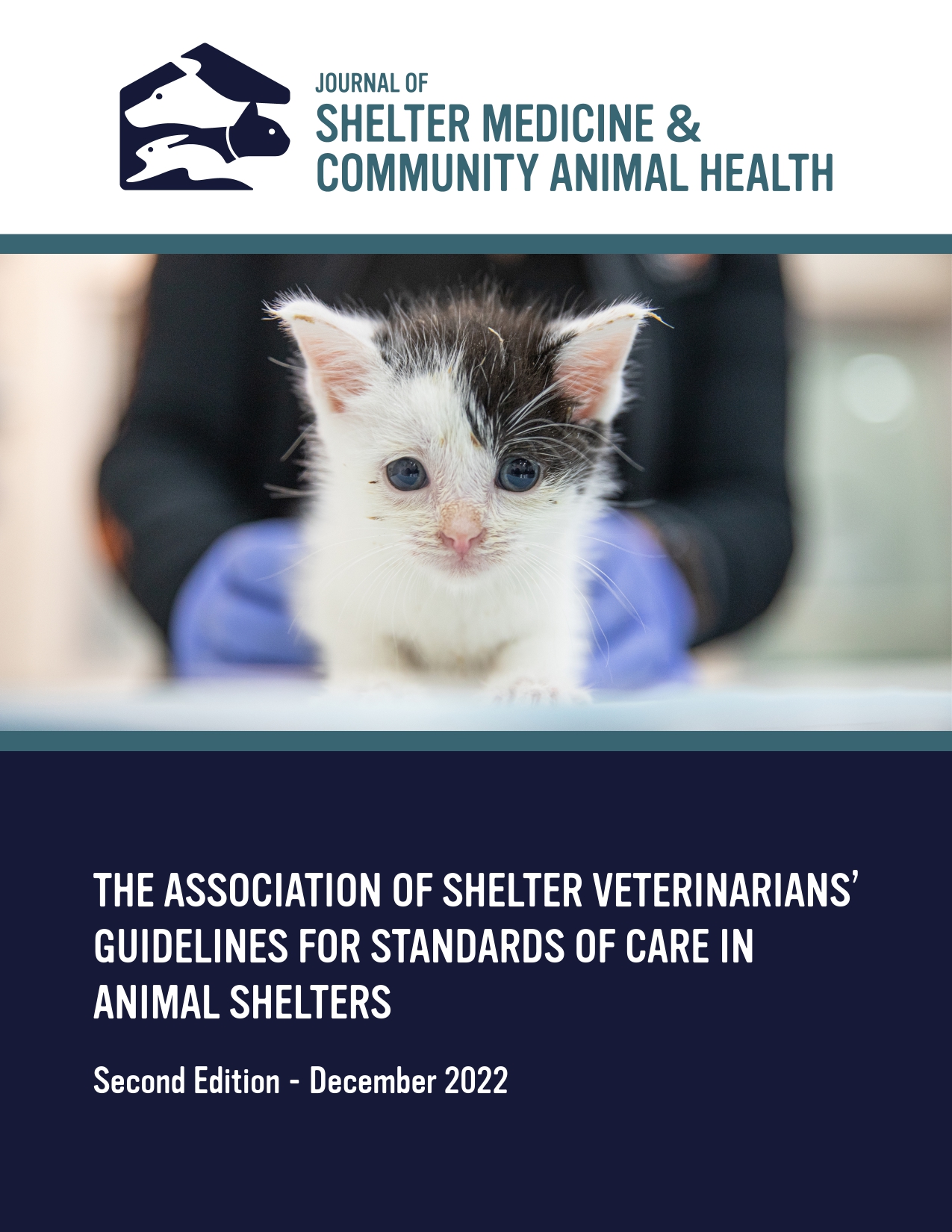Finding Yourself in the Arena of Scientific Writing: The Journey From Idea to Publication in Shelter and Community Medicine
DOI:
https://doi.org/10.56771/jsmcah.v2.60Keywords:
Research documentation, science communication, writing manuscripts, scientific publishing, framework for scientific writing, barriers to scientific publishing, translating research into publicationsAbstract
Irrespective of discipline, scientific study relies upon systematic reasoning from observations to formulate and refine hypotheses and develop theories that can explain documented phenomena. Our understanding of science and its influence on the world around us is ever evolving, yet science cannot advance without clear communication to disseminate findings that result from reproducible research. Veterinary and animal care team members can contribute significantly to the advancement of science by sharing ideas, experiences, perspectives, case management decisions, and patient outcomes. The uniqueness of shelter medicine, with recent emphasis on how to maintain animals within their homes, offers a wealth of observations and discoveries that are worthy of publication. For those in clinical practice in shelter and community medicine, the primary obstacles to publishing are time, confidence, and lack of familiarity or experience with the structure and style of scientific writing. Such barriers can be overcome through a combination of graduated exposure, mentoring, patience, and practice. This article explores the journey from idea to publication to encourage those in shelter and community medicine who generate and have access to vital data to come forward. Writing to publish is a teachable skill, one that the veterinary profession relies upon to translate scientific inquiry into print capable of broadening global perspectives and influencing the clinical practice of tomorrow.
Downloads
References
Li G, Jin Y, Mbuagbaw L, et al. Enhancing research publications and advancing scientific writing in health research collaborations: sharing lessons learnt from the trenches. J Multidiscip Healthc. 2018;11:245–254. doi: 10.2147/JMDH.S152681
Nolen RS. A specialty whose time has come: shelter medicine recognized as veterinary specialty. J Am Vet Med Assoc. 2014;244(11):1218–1221. doi: 10.2460/javma.244.11.1218
Einav L, Finkelstein A, Gupta A, National Bureau of Economic R. Is American pet health care (also) uniquely inefficient? NBER working paper series no 22669. National Bureau of Economic Research; 2016.
Quain A, Ward MP, Mullan S. Ethical Challenges Posed by Advanced Veterinary Care in Companion Animal Veterinary Practice. Animals (Basel). 2021 Oct 20;11(11):3010. doi: 10.3390/ani11113010
Lester B. Tear Down the Wall. Today’s Veterinary Business. 2022 (February/March). https://todaysveterinarybusiness.com/veterinary-care-models/ Accessed September 29, 2023.
Powell L, Houlihan C, Stone M, et al. Animal shelters’ response to the COVID-19 pandemic: a pilot survey of 14 shelters in the Northeastern United States. Animals (Basel). 2021;11(9): p1–76. doi: 10.3390/ani11092669
Nolen RS. Shelter veterinarians update care guidelines. AVMA News. American Veterinary Medical Association; 2023. https://www.avma.org/news/shelter-veterinarians-update-care-guidelines Accessed November 29, 2023.
Levy JK, Bard KM, Tucker SJ, Diskant PD, Dingman PA. Perioperative mortality in cats and dogs undergoing spay or castration at a high-volume clinic. Vet J. 2017;224:11–15. doi: 10.1016/j.tvjl.2017.05.013
Bushby PA. High-quality, high-volume spay-neuter: Access to care and the challenge to private practitioners. J Feline Med Surg. 2020;22(3):208–215. doi: 10.1177/1098612X20903600
McCallin AJ, Hough VA, Kreisler RE. Pyometra management practices in the high quality, high volume spay-neuter environment. Top Companion Anim Med. 2021;42:100499. doi: 10.1016/j.tcam.2020.100499
DiGangi BA, Johnson M, Isaza N. Scrotal approach to canine orchiectomy. Clinician’s Brief. 2016;(May):87–93.
Shivley JM, Woodruff K, Shealy AP, Bushby PA, Brookshire WC. Update on orchiectomy. Today’s Veterinary Practice. 2022(October). https://todaysveterinarypractice.com/soft-tissue-surgery/update-on-orchiectomy/
Miller KP, Rekers WL, DeTar LG, Blanchette JM, Milovancev M. Evaluation of sutureless scrotal castration for pediatric and juvenile dogs. J Am Vet Med Assoc. 2018;253(12):1589–1593. doi: 10.2460/javma.253.12.1589
Englar RE. An introduction to scientific writing. In: Englar RE, ed. Writing Skills for Veterinarians. 5m Publishing; 2019:162–172:chap 12.
Fingland RB, Stone LR, Read EK, Moore RM. Preparing veterinary students for excellence in general practice: building confidence and competence by focusing on spectrum of care. J Am Vet Med Assoc. 2021;259(5):463–470. doi: 10.2460/javma.259.5.463
Block G. A new look at standard of care. J Am Vet Med Assoc. 2018;252(11):1343–1344. doi: 10.2460/javma.252.11.1343
Stull JW, Shelby JA, Bonnett BN, et al. Barriers and next steps to providing a spectrum of effective health care to companion animals. J Am Vet Med Assoc. 2018;253(11):1386–1389. doi: 10.2460/javma.253.11.1386
Skipper A, Gray C, Serlin R, O’Neill D, Elwood C, Davidson J. ‘Gold standard care’ is an unhelpful term. Vet Rec. 2021;189(8):331. doi: 10.1002/vetr.1113
Choosing Wisely®: Promoting conversations between patients and clinicians. American Board of Internal Medicine (ABIM). https://abimfoundation.org/what-we-do/choosing-wisely Accessed August 11, 2023.
Perley K, Burns CC, Maguire C, et al. Retrospective evaluation of outpatient canine parvovirus treatment in a shelter-based low-cost urban clinic. J Vet Emerg Crit Care (San Antonio). 2020;30(2):202–208. doi: 10.1111/vec.12941
Venn EC, Preisner K, Boscan PL, Twedt DC, Sullivan LA. Evaluation of an outpatient protocol in the treatment of canine parvoviral enteritis. J Vet Emerg Crit Care (San Antonio). 2017;27(1):52–65. doi: 10.1111/vec.12561
Cooper ES, Owens TJ, Chew DJ, Buffington CA. A protocol for managing urethral obstruction in male cats without urethral catheterization. J Am Vet Med Assoc. 2010;237(11):1261–1266. doi: 10.2460/javma.237.11.1261
Nissen T, Wynn R. The history of the case report: a selective review. JRSM Open. 2014;5(4):2054270414523410. doi: 10.1177/2054270414523410
Alsaywid BS, Abdulhaq NM. Guideline on writing a case report. Urol Ann. 2019;11(2):126–131. doi: 10.4103/UA.UA_177_18
Parkinson J. An essay on the shaking palsy. 1817. J Neuropsychiatry Clin Neurosci. 2002;14(2):223–236; discussion 222. doi: 10.1176/jnp.14.2.223
Rodriguez L, Berliner EA. Outbreak management of multidrug-resistant Bordetella bronchiseptica in 16 shelter-housed cats. J Feline Med Surg. 2023;25(2):1098612X231153051. doi: 10.1177/1098612X231153051
Rozental T, Ferreira M, Gomes R, et al. A cluster of Rickettsia rickettsii infection at an animal shelter in an urban area of Brazil. Epidemiol Infect. 2015;143(11):2446–2450. doi: 10.1017/S0950268814003161
Christopher M, Young K. Writing for Publication in Veterinary Medicine: A Practical Guide for Researchers and Clinicians. John Wiley & Sons, Inc.; 2015:28. https://onlinelibrary.wiley.com/pb-assets/assets/1939165X/VETWritingforPubPDF-1658767575.pdf. Accessed November 29, 2023.
Bartz C. It all starts with an idea. Alzheimer Dis Assoc Disord. 1999;13(1):S106–S110.
Cain CJ, Woodruff KA, Smith DR. Phenotypic Characteristics Associated with Shelter Dog Adoption in the United States. Animals. 2020;10(11):1959. doi: 10.3390/ani10111959
Jones HD, Hart CL. Black cat bias: prevalence and predictors. Psychol Rep. 2020;123(4):1198–1206. doi: 10.1177/0033294119844982
Rix C, Westman M, Allum L, Hall E, Pockett J, Pegram C, Serlin R. The Effect of Name and Narrative Voice in Online Adoption Profiles on the Length of Stay of Sheltered Cats in the UK. Animals. 2021;11(1):62. doi: 10.3390/ani11010062
Machi LA, McEvoy BT. The literature review : six steps to success. 3rd ed. Corwin; 2016:xix:166 pages.
Scrotal castration versus prescrotal castration in dogs. DVM360. 2015. https://www.dvm360.com/view/scrotal-castration-versus-prescrotal-castration-dogs. Accessed November 29, 2023.
Fossum TW. Surgery of the reproductive and genital systems. In: Fossum TW, ed. Small Animal Surgery. Elseview; 2002:619–620.
Howe LM. Surgical methods of contraception and sterilization. Theriogenology. 2006;66(3):500–509. doi: 10.1016/j.theriogenology.2006.04.005
Miller L, Zawistowski S. Efficient spay neuter techniques. In: Miller L, Zawistowski S, eds. Shelter Medicine for Veterinarians and Staff. Wiley-Blackwell; 2013:635–637.
Simon EL, Osei-Ampofo M, Wachira BW, Kwan J. Getting accepting – succesful writing for scientific publication: a Research Primer for low- and middle-income countries. Afr J Emerg Med. 2020;10(2):S154–S157. doi: 10.1016/j.afjem.2020.06.006
Simpson SH. Creating a data analysis plan: what to consider when choosing statistics for a study. Can J Hosp Pharm. 2015;68(4):311–317. doi: 10.4212/cjhp.v68i4.1471
Regan M, Pietrobon R. A conceptual framework for scientific writing in nursing. J Nurs Educ. 2010;49(8):437–443. doi: 10.3928/01484834-20100430-02
Iskander JK, Wolicki SB, Leeb RT, Siegel PZ. Successful scientific writing and publishing: a step-by-step approach. Prev Chronic Dis. 2018;15:E79. doi: 10.5888/pcd15.180085
Stiell IG, Canadian EMWG. Guide to writing and publishing a scientific manuscript: part 2-the process. CJEM. 2022;24(2):120–122. doi: 10.1007/s43678-021-00242-4
Stiell IG, Canadian EMWG. Guide to writing and publishing a scientific manuscript: Part 1-The structure. CJEM. 2022;24(2):117–119. doi: 10.1007/s43678-021-00241-5
Morton PG. Why was my manuscript rejected? J Prof Nurs. 2020;36(2):1–4. doi: 10.1016/j.profnurs.2020.02.006
Bajwa SJ, Sawhney C. Preparing manuscript: Scientific writing for publication. Indian J Anaesth. 2016;60(9):674–678. doi: 10.4103/0019-5049.190625
Glasper EA, Peate I. Writing for publication: science and healthcare journals. Br J Nurs. 2013;22(16):964–966.
Singh V, Mayer P. Scientific writing: strategies and tools for students and advisors. Biochem Mol Biol Educ. 2014;42(5):405–413. doi: 10.1002/bmb.20815
Gutman SA. Writing resources – mentors, writing partners, and self-discipline. In: Gutman SA, ed. Journal Article Writing and Publication: Your Guide to Mastering Clinical Health Care Reporting Standards. SLACK Incorporated; 2017:chap 2.
Fraser D. Collins concise dictionary of quotations. 3rd ed. Collins; 1998.
Guilford WH. Teaching peer review and the process of scientific writing. Adv Physiol Educ. 2001;25(1–4):167–175. doi: 10.1152/advances.2001.25.3.167
Behzadi P, Gajdacs M. Writing a strong scientific paper in medicine and the biomedical sciences: a checklist and recommendations for early career researchers. Biol Futur. 2021;72(4):395–407. doi: 10.1007/s42977-021-00095-z
Khadilkar SS. The art and craft of making a draft: writing a good-quality scientific paper! J Obstet Gynaecol India. 2018;68(3):151–154. doi: 10.1007/s13224-018-1133-5
Wager E, Godlee F, Jefferson T. How to Survive Peer Review. BMJ Books; 2002.
Jatin S, Anand S, Ricardo P. Scientific writing of novice researchers: what difficulties and encouragements do they encounter? Acad Med. 2009;84(4):511–516. doi: 10.1097/ACM.0b013e31819a8c3c
Gutman SA. Introduction: the importance of writing to advance your career and profession. In: Gutman SA, ed. Journal Article Writing and Publication: Your Guide to Mastering Clinical Health Care Reporting Standards. SLACK Incorporated; 2017:chap 1.
Jerde CL, Taper ML. Preparing undergraduates for professional writing: evidence supporting the benefits of scientific writing within the biology curriculum. J Coll Sci Teach. 2004;33(7):34–37.
Phadtare A, Bahmani A, Shah A, Pietrobon R. Scientific writing: a randomized controlled trial comparing standard and on-line instruction. BMC Med Educ. 2009;9:27. doi: 10.1186/1472-6920-9-27
Fellows NJ. A Window into thinking: using student writing to understand conceptual chance in science learning. J Res Sci Teach. 1994;31(9):985–1001.
MacArthur CA, Graham S, Fitzgerald J. Handbook of writing research. Guilford Press; 2006:xi, 468 p.
Flower L, Hayes JR. A cognitive process theory of writing. Coll Compos Commun. 1981;32:365–387.
Pololi L, Knight S, Dunn K. Facilitating scholarly writing in academic medicine. J Gen Intern Med. 2004;19(1):64–68. doi: 10.1111/j.1525-1497.2004.21143.x
Association of Shelter Veterinarians’ Veterinary Task Force to Advance S-N, Griffin B, Bushby PA, et al. The Association of Shelter Veterinarians’ 2016 Veterinary Medical Care Guidelines for Spay-Neuter Programs. J Am Vet Med Assoc. 2016;249(2):165–188. doi: 10.2460/javma.249.2.165
Hurley KF, Levy JK. Rethinking the animal shelter’s role in free-roaming cat management. Front Vet Sci. 2022;9:1–11.
Boone JD, Miller PS, Briggs JR, et al. A long-term lens: cumulative impacts of free-roaming cat management strategy and intensity on preventable cat mortalities. Front Vet Sci. 2019;6:238. doi: 10.3389/fvets.2019.00238
Additional Files
Published
Issue
Section
License
Copyright (c) 2023 Ryane E. Englar

This work is licensed under a Creative Commons Attribution 4.0 International License.










